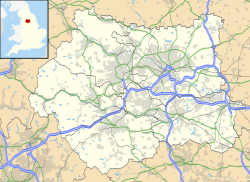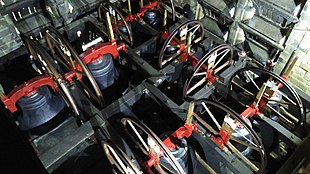
The Church of St Mary the Virgin, widely known as St Mary Redcliffe, is the main Church of England parish church for the Redcliffe district of the city of Bristol, England. The first reference to a church on the site appears in 1158, with the present building dating from 1185 to 1872. The church is considered one of the country's finest and largest parish churches as well as an outstanding example of English Gothic architecture. The church is so large it is sometimes mistaken for Bristol Cathedral by tourists. The building has Grade I listed status, the highest possible category, by Historic England.

St Nicholas Church is a Church of England parish church in Kenilworth, Warwickshire, England.

St Mary's Creative Space, formerly the Church of St Mary-on-the-Hill, stands at the top of St Mary's Hill, Chester, Cheshire, England, near Chester Castle. It is recorded in the National Heritage List for England as a designated Grade I listed building. The church stands at the top of a narrow winding lane which leads down to the River Dee, and it is adjacent to Chester Castle. In the 1970s the church was converted into an educational centre. It is currently available for use as a concert and exhibition venue and the Chester Music Society hold many concerts there throughout the year. The venue is programmed by Theatre in the Quarter, and hosts a variety of art and cultural events, from homegrown Cestrian performers, national and international acts.

Brailes is a civil parish about 3 miles (5 km) east of Shipston-on-Stour in Warwickshire, England. It includes the two villages of Lower and Upper Brailes which are located in the north Cotswolds, but it is often referred to as one village as the two villages adjoin each other. The parish includes the village of Winderton about 1.5 miles (2.4 km) northeast of Brailes, and the deserted medieval village of Chelmscote about 3.5 miles (5.6 km) north of Brailes. The parish is bounded to the east by Ditchedge Lane and Beggars' Lane, which are a historic ridgeway that also forms part of the county boundary with Oxfordshire. The northeastern boundary is a minor road, part of which follows the course of a Roman road.

St Mary's Church is in the village of Dodleston, Cheshire, England. It is recorded in the National Heritage List for England as a designated Grade II listed building. It is an active Anglican parish church in the diocese of Chester, the archdeaconry of Chester and the deanery of Chester.
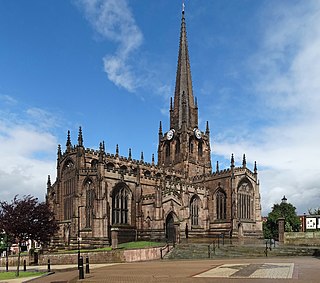
The Minster Church of All Saints or Rotherham Minster is the Anglican minster church of Rotherham, South Yorkshire, England. The Minster is a prominent example of Perpendicular Gothic architecture and various architectural historians have rated it highly. Nikolaus Pevsner describes it as "one of the largest and stateliest churches in Yorkshire", Simon Jenkins states it is "the best work in the county", and Alec Clifton-Taylor calls it the "glory of Rotherham". With its tall spire, it is Rotherham's most predominant landmark, and amongst the tallest churches in Yorkshire.

Wigginton is a village and civil parish about 6 miles (10 km) southwest of Banbury in Oxfordshire. The village is beside the River Swere, which forms the southern boundary of the parish. A Channel Four documentary, Hitler's British Girl, investigated the possibility that Unity Mitford gave birth to the son of Adolf Hitler in Hill View Cottage, Wigginton.

The Church of All Saints is the Church of England parish church for the large village of Wrington, Somerset, England. There has been a church here since the 13th century, though much of the present building dates from the 15th century. Historic England have designated it a Grade I listed building.

The ParishChurch of St Mary, more commonly known as St Mary's, is the main Church of England parish church for the town of Bridgwater, Somerset. Originally founded well before the Norman Conquest, the present church is a large and impressive structure dating primarily from the 14th and 15th centuries, with both earlier remains and later additions.

The Church of St Mary in Bruton, Somerset, England was largely built in the 14th century. Like many Somerset churches, it has a very fine tower; less usually it has a second one as well. Simon Jenkins has called Bruton's tower "Somerset architecture at its most powerful." It has been designated a Grade I listed building.
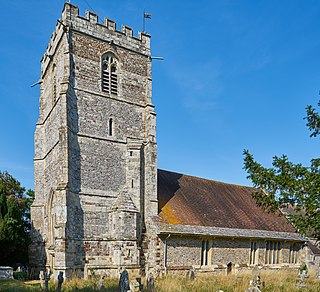
Cranborne Priory is a former priory church in the village of Cranborne, Dorset, England. Founded in 980 as Cranborne Abbey, it became a priory in 1102, remaining that way until it was dissolved in 1540. The tower, nave and aisles from the priory survive to form the Church of St Mary and St Bartholomew, the parish church of Cranborne. The building, which has fragments from the 12th century, is designated a Grade I listed building.

All Souls Church, Halifax, is a redundant Anglican church in Haley Hill, Halifax, West Yorkshire, England. It is recorded in the National Heritage List for England as a designated Grade I listed building, and is under the care of the Churches Conservation Trust. The church is open to visitors at limited times.

Seckington is a village and civil parish in North Warwickshire, about 4 miles (6 km) northeast of Tamworth. The B5493 road between Tamworth and Appleby Magna runs through the parish, passing about 100 yards (91 m) north of the village. Seckington shares a parish council with Newton Regis and No Man's Heath. Forming part of the border with Staffordshire, it is the second most northerly settlement in Warwickshire, with only No Man's Heath situated further north, and is only 3.5 miles due south of the Derbyshire border.

St Mary's Church is the main Church of England parish church for the areas of Portsea and Fratton, both located in the city of Portsmouth, Hampshire. Standing on the oldest church site on Portsea Island, the present building, amongst the largest parish churches in the country, has been described as the "finest Victorian building in Hampshire". It is at least the third church on the site and has been designated a Grade II* listed building by Historic England. Former regular worshippers here have included Charles Dickens, Isambard Kingdom Brunel, and Cosmo Lang.

The Church of St James is the parish church for the village of Kingston, located on the Isle of Purbeck in Dorset. The church is a notable example of the Gothic Revival style and is a Grade I listed building.

St James's Church is the main Church of England parish church for the town of Trowbridge, Wiltshire, England. The 15th-century Grade I listed building is the town's most prominent landmark.
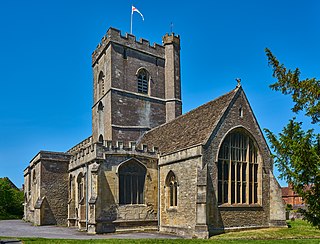
The Church of All Saints is the main Church of England parish church in Westbury, Wiltshire, England. There has been a church on the site since Saxon times, and the current church, largely rebuilt around 1437, is a Grade I listed building.

The Church of All Saints is the Church of England parish church for the village of Netheravon, Wiltshire, England. A church has stood on this site near the River Avon since Saxon times. It has been designated a Grade I listed building.

The Church of St Michael and All Angels is the main Church of England parish church for the suburb of Heavitree, located in the city of Exeter, Devon. The present building is a large and imposing Gothic Revival structure dating back to the 19th century but there has been a church on the site since Saxon times. Designated as a Grade II* listed building by Historic England, the church is notable for its Victorian architecture, tall tower and proximity to the 'Heavitree Yew', an ancient common yew tree within the churchyard amongst the oldest in the county.

The Church of St Mary the Virgin is the main Church of England parish church for the village of Uffculme, Devon, England. First mentioned in a charter dating back to 1136, the present church has a mixture of medieval and Victorian architecture and is a Grade II* listed building. The church building is notable for its rood screen, the longest and oldest in the county, as well as its tall broach spire, a rare feature on churches in Devon.

